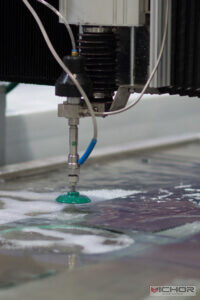
Unlocking the Potential of a Water Jet Machine Shop: Key Insights for Modern Manufacturing
In today’s fast-paced industrial landscape, precision and efficiency are paramount. Imagine a tool that can slice through virtually any material with the finesse of a surgeon’s scalpel, all while keeping costs low and environmental impact minimal. This is where a water jet machine shop comes into play. As a cornerstone of advanced manufacturing, these shops leverage high-pressure water jet technology to deliver unparalleled cutting solutions. Whether you’re in aerospace, automotive, or custom fabrication, understanding the capabilities of a water jet machine shop can transform your production processes. In this article, we’ll dive into the essential aspects that make these shops indispensable, from their operational mechanics to their broad applications and beyond. By the end, you’ll see why a water jet machine shop is more than just a service—it’s a strategic asset for innovation and growth.
What is a Water Jet Machine Shop?
A water jet machine shop is a specialized facility that utilizes high-pressure water jets, often mixed with abrasive materials, to cut, shape, and machine a wide range of materials. Unlike traditional methods such as laser or plasma cutting, water jet technology relies on a focused stream of water traveling at supersonic speeds to achieve precise cuts without generating heat-affected zones. This makes it ideal for materials that are sensitive to high temperatures, such as metals, composites, glass, and stone. The core equipment in a water jet machine shop includes pumps that generate pressures up to 90,000 psi, motion control systems for accuracy, and abrasive delivery systems for enhanced cutting power. Essentially, a water jet machine shop serves as a hub for custom fabrication, prototyping, and production runs, offering versatility that few other methods can match. By integrating computer-aided design (CAD) software, these shops ensure that every cut is exact, repeatable, and tailored to client specifications, making them a go-to solution for industries demanding high precision and flexibility.
How Water Jet Technology Works
The operation of a water jet machine shop hinges on a fascinating blend of physics and engineering. At its heart, the process involves pressurizing water to extreme levels using intensifier pumps or direct-drive systems. This high-pressure water is then forced through a small nozzle, creating a thin, coherent stream that can reach speeds of over 2,500 feet per second. For cutting harder materials like metals or ceramics, an abrasive substance—typically garnet—is introduced into the stream, turning the water jet into a powerful cutting tool. The entire system is controlled by advanced software that translates digital designs into precise movements of the cutting head, allowing for intricate patterns and tight tolerances. One of the standout features of a water jet machine shop is its cold-cutting process, which eliminates thermal distortion, warping, or material hardening. This is crucial for applications where material integrity is non-negotiable. Additionally, the technology is highly adaptable; it can handle thicknesses from a few millimeters to over a foot, depending on the material. By leveraging this method, a water jet machine shop delivers clean edges, minimal kerf width, and the ability to cut complex shapes without secondary finishing, saving time and resources.
Advantages of Using a Water Jet Machine Shop
Choosing a water jet machine shop offers a multitude of benefits that cater to diverse manufacturing needs. First and foremost is versatility—a water jet machine shop can process an extensive array of materials, including metals, plastics, rubber, stone, and composites, without the need for tool changes or setup adjustments. This flexibility translates to reduced lead times and lower costs for multi-material projects. Another significant advantage is precision; water jet cutting achieves tolerances as tight as ±0.003 inches, ensuring parts fit perfectly in assemblies. Moreover, the absence of heat input means no heat-affected zones, preserving the material’s original properties and reducing waste. Environmentally, a water jet machine shop is a sustainable choice, as it uses water and natural abrasives, producing minimal hazardous byproducts and allowing for easy recycling of materials. From an economic perspective, the technology minimizes material usage through nested cutting patterns, optimizing yield and reducing scrap. Lastly, safety is enhanced since there are no toxic fumes or radiation risks, unlike with laser or plasma systems. Overall, a water jet machine shop provides a balanced mix of efficiency, quality, and eco-friendliness that supports long-term operational success.
Applications Across Various Industries
The adaptability of a water jet machine shop makes it a vital resource across numerous sectors. In the aerospace industry, for instance, it is used to cut lightweight alloys and composites for aircraft components, where precision and weight savings are critical. The automotive sector relies on a water jet machine shop for fabricating parts like gaskets, interior panels, and custom brackets, benefiting from the method’s ability to handle diverse materials without delamination. In architecture and design, a water jet machine shop produces intricate patterns in stone, glass, and metal for decorative elements, flooring, and façades, enabling creative freedom with structural integrity. The manufacturing and industrial equipment fields utilize these shops for prototyping and producing machine parts, jigs, and fixtures, thanks to the quick turnaround and high accuracy. Even the food industry employs water jet technology—though in a specialized form—for cutting products like frozen foods or pastries without contamination. By serving such a broad spectrum, a water jet machine shop proves its value as a cross-industry solution, driving innovation and customization in ways that traditional methods cannot.
Materials Processed in a Water Jet Machine Shop
A key strength of a water jet machine shop lies in its ability to handle an impressive variety of materials. Metals such as steel, aluminum, titanium, and copper are commonly cut, with the water jet method avoiding the hardening or weakening that heat-based processes cause. Plastics and polymers, including acrylics, polycarbonate, and PVC, are processed cleanly without melting or emitting harmful vapors. In the realm of composites, a water jet machine shop excels at cutting carbon fiber, fiberglass, and Kevlar without fraying or delamination, which is essential for high-performance applications. Natural materials like granite, marble, and glass are also frequently handled, allowing for detailed designs in countertops, art pieces, and architectural features. Additionally, rubber, foam, and ceramics can be precisely shaped for industrial seals, insulation, and electronic components. This material diversity means that a water jet machine shop can serve as a one-stop solution for projects involving multiple substance types, streamlining supply chains and reducing the need for outsourcing. The non-contact nature of the cutting process further ensures that delicate materials remain intact, underscoring the technology’s reliability.
cutting carbon fiber, fiberglass, and Kevlar without fraying or delamination, which is essential for high-performance applications. Natural materials like granite, marble, and glass are also frequently handled, allowing for detailed designs in countertops, art pieces, and architectural features. Additionally, rubber, foam, and ceramics can be precisely shaped for industrial seals, insulation, and electronic components. This material diversity means that a water jet machine shop can serve as a one-stop solution for projects involving multiple substance types, streamlining supply chains and reducing the need for outsourcing. The non-contact nature of the cutting process further ensures that delicate materials remain intact, underscoring the technology’s reliability.
Cost-Effectiveness and Efficiency
When evaluating manufacturing options, the economic aspects of a water jet machine shop often stand out. Initially, the investment in water jet technology might seem higher than for conventional tools, but the long-term savings are substantial. For one, a water jet machine shop reduces material waste through optimized nesting software, which arranges parts to maximize sheet utilization. This efficiency lowers raw material costs and minimizes disposal fees. Labor costs are also curtailed because the automated systems require minimal operator intervention once programmed, allowing staff to focus on other tasks. Maintenance in a water jet machine shop is relatively straightforward, with consumables like nozzles and abrasive materials being affordable and long-lasting. Furthermore, the speed of cutting—especially for thinner materials—can rival or exceed that of other methods, leading to faster project completion and increased throughput. By eliminating the need for secondary processes like deburring or heat treatment, a water jet machine shop cuts down on additional expenses and time. In essence, the total cost of ownership for services from a water jet machine shop is competitive, making it an economically smart choice for both small businesses and large corporations.
Environmental and Safety Considerations
In an era where sustainability is crucial, a water jet machine shop offers notable environmental benefits. The primary cutting medium is water, which is often recycled within closed-loop systems to conserve resources. Abrasives like garnet are non-toxic and can be reused or disposed of safely, reducing ecological footprints. Unlike thermal cutting methods, a water jet machine shop does not produce harmful emissions, fumes, or dust, contributing to cleaner air in the workspace. This aligns with global regulations and corporate social responsibility goals. From a safety perspective, operators in a water jet machine shop are not exposed to high temperatures or radiation, lowering the risk of accidents. The equipment typically includes safeguards such as emergency stops and enclosed cutting areas to prevent injuries. Noise levels are manageable with proper insulation, and the lack of combustible materials in the process reduces fire hazards. By prioritizing both planet and people, a water jet machine shop not only enhances operational ethics but also appeals to environmentally conscious clients, giving businesses a competitive edge.
Frequently Asked Questions About Water Jet Machine Shops
Q1: What types of materials can a water jet machine shop handle?
A1: A water jet machine shop can process a wide range of materials, including metals (like steel, aluminum, and titanium), plastics, composites, stone, glass, ceramics, and rubber. This versatility makes it suitable for diverse industries, from aerospace to art and design.
Q2: How precise is water jet cutting compared to other methods?
A2: Water jet cutting is highly precise, achieving tolerances as tight as ±0.003 inches. It outperforms many traditional methods in accuracy, especially for complex shapes and heat-sensitive materials, due to its cold-cutting process that avoids thermal distortion.
Q3: Is water jet technology environmentally friendly?
A3: Yes, water jet technology is considered environmentally friendly. It uses water and natural abrasives, produces no hazardous fumes, and often incorporates water recycling systems. This reduces waste and energy consumption, supporting sustainable manufacturing practices.
Q4: What are the typical applications for a water jet machine shop?
A4: Common applications include cutting parts for aerospace and automotive industries, creating architectural elements, prototyping products, fabricating machinery components, and producing custom art or signage. Its adaptability allows it to serve sectors requiring high precision and material diversity.
Q5: How does the cost of using a water jet machine shop compare to other cutting services?
A5: While initial costs might be higher, water jet services are cost-effective in the long run due to reduced material waste, lower labor requirements, and minimal need for secondary processing. The efficiency and versatility often lead to overall savings, especially for complex or multi-material projects.
continue reading
Related Posts
- 1352 words6.8 min read
- 1378 words6.9 min read


